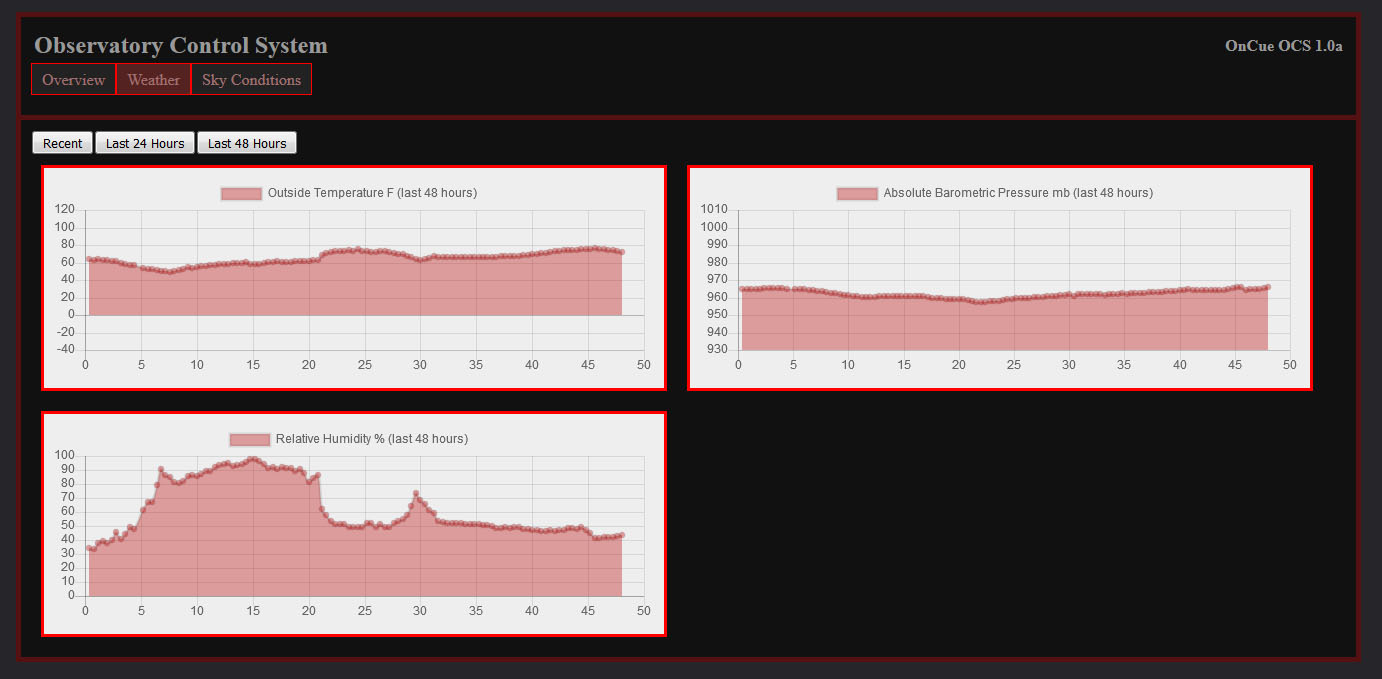The OnCue OCS (Observatory Control System) should be of help to capable DIY’ers who want to automate small observatories. It’s based on using an inexpensive and easy to work with Arduino Microcontrollers (Mega2560, Teensy, ESP32) to control some relays and sense switch closures and analog inputs and operate weather sensors which are usually on an I2C bus.
The OCS hooks up to your wired LAN (router, etc.) and provides a website which can monitor/control power, heating and cooling systems, lighting, roll-off roof, dome, and also monitor weather conditions.
There are two OCS ASCOM drivers available for a small fee.
ASCOM aware Windows software can then connect to the OCS via. the USB/Serial interface or IP interfaces.
These allow monitoring of and response to the safety status, and for operating a roof/shutter.
Purchase the OCS ASCOM drivers
Note: This is just an introduction, much more information and help is available by joining the OCS Group at Groups.io.
The OnCue OCS can handle the following from an internet accessible web-site.
All panels except the “Status” panel are optional, and most items on the panels can be disabled if you’re not using them.
Status Panel:
Date/Time. NTP support for setting the date/time from the internet.
Up Time. Number of minutes since the controller booted up last.
Optionally you can enable the Watchdog timer and the OCS will reboot automatically should it hang for some reason.
AC Mains power good (a digital input.) Signals an “UNSAFE” condition if mains power fails (running on UPS for example.)
AC Mains current (an Analog Input.)
AC Mains current Aux (an Analog Input.)
Monitor DC telescope voltage (an Analog Input.)
Monitor DC telescope current (an Analog Input.)
Monitor battery for DC roof motor etc. voltage (an Analog Input.)
Monitor battery for DC roof motor etc. current (an Analog Input.)
Weather Panel:
Outside Temperature.
Barometric Pressure.
Relative Humidity.
Wind Speed*. Signals an “UNSAFE” condition if too high.
Rain. Signal an “UNSAFE” condition if wet.
Sky Quality*. In mag/sq arc-sec.
Sky Conditions (cloud cover.) Signals an “UNSAFE” condition if too cloudy.
* = Actual routines to read these sensors aren’t present, just function shells.
Power Panel:
For up to six named relays (AC Outlets, DC Telescope power, etc.)
Each relay can have setting memory activated to restore it’s state across a power cycle.
Thermostat Panel:
Shows inside temperature.
Shows inside humidity.
Allows setting minimum temperature (heat relay control.)
Allows setting maximum temperature (cool relay control.)
Lighting Panel:
Controls for red and white lights.
Separate controls for “observing room” and “warm room”.
Controls for timed “exit” light.
Roof/shutter Panel:
Controls for roof or dome shutter.
Controls to open or close the roof/shutter and to override safety features if necessary.
Option to automatically close the roof at 8AM (Standard Time.)
Option to automatically close the roof if an “UNSAFE” condition is detected.
Slow PWM for DC motors. Set frequency (1 to 100Hz.) Set power in 10% intervals (10% to 100%.)
Slow PWM soft start for DC motors (ramps up at 5% per second until normal power % is reached.)
Direction control via two signals A and B. A=HIGH and B=LOW to open the roof, A=LOW and B=HIGH to close the roof, both are held LOW to stop motion.
A pair of SPDT relay’s can use this to change the direction of a DC motor.
Roof/shutter Safety:
Timed cut-off (if limit switch fails, etc. motor doesn’t operate forever.)
Where possible detects open and close limit switch failures.
On open start, 4 seconds allowed for closed switch to disengage.
On close start, 4 seconds allowed for open switch to disengage.
Both open and close switches active (should never happen.)
Two power switching methods, by direction relay control and by a power control relay (which is actually a MOSFET power transistor for my DC roof motor.)
Dome Panel:
Dome shutter interlock to disable dome motion unless the shutter is open.
Dome motor drive configuration parameters for both Altitude and Azimuth:
Support for step/dir interface drivers and servos (DC motor.)
Software rate of motion.
Software defined motion limits.
Optional home switches.
Optional limit switches.
The Weather page:
The OCS logs weather data at 30s intervals to an Micro SD card log-file, one log-file per day. Logs files consume about 82MB of storage space per year.
The logging is optional and the Micro SD card also needs Chart.min.js renamed to Chart.js and placed in it’s root directory.
A graphic display of the recent log data is then made available:

OCS hardware:

Above is an example of the latest hardware, Teensy4.1 based. It’s also possible to build out more minimal designs.
Again, the OCS Group and its Wiki at Groups.io has more information.

